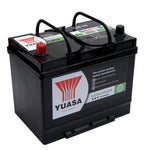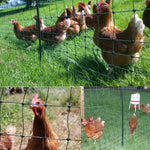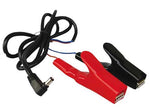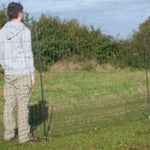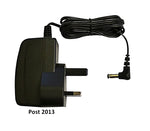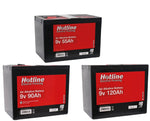You have no items in your shopping cart.
Frequently Asked Questions
Some frequently asked questions as they relate to Electric Fencing.
Is Electric Fencing Safe for my Horses?
Why is an electric fence better than other types of horse fences?
What's the best way to fence aggressive horses or stallions?
How do I prevent "cribbing" or Wind Sucking?
Is electric fence safe for my pets?
A reason for shorting?
Crocodile clips give a good connection?
When is the best time to check the power in your fence?
Pigs and electric fencing?
Where to put your earth stake?
What is an electric fence system made up of and how does it work? How do I start building my electric fence?
How do I choose the most suitable electric fence energiser?
What is the most common installation error with electric fencing?
My climate and soil make it difficult for me to install a good earthing system. What alternatives do I have? What are the advantages of electric fence over conventional barrier fence?
If I use barbed wire, can I electrify it?
How do I use electric fence to contain bulls?
How does an electric fence work with rotational and strip grazing?
Can I electrify an existing wood, vinyl or chain link fence?
What is a Joule? A measurement of energy.
I have a Car Battery - May I simply connect that to the fence?
Why does the voltage increase as I move down the fence-line?
Is electric fencing safe for my horses?
The short sharp shock your horse receives from an electric fence will not injure it, but will teach it to respect and avoid the fence. Very roughly, the shock produced by a small energiser is similar to a sharp whack by a riding crop. Traditional fencing is more apt to injure horses when they get scared or spooked and attempt to push through or jump over it. A properly installed electric fence system is the safest, most visible method to keep your horses contained.
For a more detailed article on the Safety Of Electric Fencing.
Why is electric fence better than other types of horse fences?
Electric fencing is the most cost effective and efficient method of containing horses while safeguarding them from injury. Barbed wire, woven-wire, and wooden fences can injure a "spooked" horse that attempts to run through or jump over them. Injuries a horse will sustain if it gets tangled in barbed wire may be fatal.
Electric fencing is lower cost, easier to install, requires less maintenance and controls horses more effectively than traditional fencing.
What's the best way to fence aggressive horses or stallions?
If normally kept segregated for breeding purposes, stallions or other aggressive horses may become highly motivated to escape confinement, especially when nearby mares are in heat.
To contain aggressive horses, maintain 5,000 - 6,000 volts to the end of the fence line. Three or four strands of fence wire are best. The more aggressive the horse, the higher the shock must be to discourage them. Often baiting the fence with treacle or syrup will keep even the most determined stallion in a fence.
How do I prevent "cribbing" or Wind Sucking?
An electrified wire can easily be added wire to an existing fence. This option can prevent "cribbing" or chewing the tops of wood fences, as well as keep horses from jumping, or prevent animal pressure on the fence. It is critical that the hot electrical wire does not touch the wooden fence. A range of insulators is available to allow an electrified wire to be erected on the top or interior of the fence. Offset type insulators will put the fence wire away from the existing fence, preventing animals from pressing against it.
Is electric fence safe for my pets?
The short, sharp shock your pet receives from an electric fence will get their attention, but not harm the animal. This will teach it to avoid the fence in the future and stay within the boundary. For a more detailed article on the Safety Of Electric Fencing.
A reason for shorting?
The short live and earth cables that go from the energiser to the main fence wire and earth rod will crack over a period of time. If it rains the water will enter the cracks and the system may well short.
When it is wet a slack fencing line, be it rope, tape, wire or polywire could become very close to an earthing point (a wooden post or tree or grass). The electric pulse will try to jump the gap and hey presto the system will not be working correctly. Just walk around and listen for the crack noise and check where it is coming from.
Crocodile clips give a good connection?
Crocodile clips tend to cut into plastic tape and rope reducing their effectiveness. Crocodile clips when out in the elements can go rusty over time. Check them at the beginning of the year and replace them if needs be. Nothing beats a good connection. A few pounds spend will make all the difference to the effectiveness of your fence.
When is the best time to check the power in your fence?
You may not like it but the best time to check an electric fence is when it is raining. For example you may have had a permanent fence system up for 4 or 5 years and one insulator may have cracked. The water will fill the crack and create a path for the electric current to reach the wood post and so go to earth. There will be no noise when the sun is shining but when it is raining the water will enter the crack and touch the screw thread and this will short the fence out through the wooden post. Just walk around your fence and listen for the spark to crack.
Pigs and electric fencing?
Pigs tend to charge forward when they get a shock from electric fencing when applied behind the head. Always target the nose height of the pigs when positioning the wires and ensure that your fence is sufficiently tensioned - use in-line tensioners within your system or corner pulley/egg insulators at corners. Pigs are pretty easy as they are inquisitive, have a tender nose and have little natural insulation. Many free range pig farmers successfully utilise Electric Fencing.
Where to put your earth stake?
Never put an earth stake near a building where there could be a municipal earthing system. Make sure your earth stake is in moist ground and at least three quarters of the earth stake is in the ground.The earth stake is an integral part of your electric fencing system and without it your fence will not work properly.
What is an electric fence system made up of and how does it work?
An electric fence system comprises of 3 main items: an energiser, wire/rope/tape or electric netting and power supply (either mains or battery). You will usually also have posts (to support the wire/rope/tape/netting), an earth stake (to complete the circuit) and, depending on your specifications, some insulators (to ensure good conductivity), and warning signs.The power supply (mains or battery) powers the energiser which in turn sends an electrical pulse down the wire/rope/tape/netting. When an animal touches the fence it receives a short sharp shock as it creates an earth and completes the circuit.
For more information please go to What is Electric Fencing?
How do I start building my electric fence?
Electric Fencing is ideally suited to a DIY installation. Very much easier than standard stock fencing. Follow this simple Installation guide and you cannot go wrong. Service the fence regularly by checking the voltages on the fence and earth and clearing vegetation growth.
How do I choose the most suitable electric fence energiser?
The energiser you choose depends on many variables, including the type of animal being controlled, the length of the fence, its location, and even the climate (wet climates can drain energy from the fence and dry climates can cause earthing problems). In general, choose a higher powered energiser than you think you need to handle unexpected challenges such as vegetation and to allow for possible future expansion of your fence. This article Choosing an Energiser will give far more detail. Common Mistakes people erecting Electric Fences Make.
What is the most common installation error with electric fencing?
Ineffective earth systems account for 95 percent of all electric-fencing problems. When using portable fences, use the correct earth stake as recommended. In dry, rocky or sandy soil conditions more than one may be necessary. When using mains energisers in a fixed position, use at least 2, metre long galvanized earth stakes. Make sure to use bolts to attach the earth wire and tighten firmly. The drier the soil, the more extensive the earth system needs to be. Always check the earth immediately following installation and at periodic intervals, particularly in summer. If excessive voltage readings are found, add more earth stakes at 2 metre spacing until the voltage is within tolerance levels. Common Mistakes people erecting Electric Fences Make.
My climate and soil make it difficult for me to install a good earthing system. What alternatives do I have?
In sandy or rocky soils, in extremely arid climates, or where the ground is frozen for much of the year, the standard earth system may not prove adequate. In these situations it may be necessary to wire the fence with alternative wires being live / earth. Such a fence will then no longer be dependent on moist soil conditions. When an animal touches the live and earth wires simultaneously, the current will travel back to the energiser's earth system, completing the circuit and delivering a shock. Improve your Fence and make it more effective.
What are the advantages of electric fence over conventional barrier fence?
Electric fencing costs less, is easier to install, requires less maintenance and can control livestock better than barbed wire or many other types of fencing. In addition, livestock are frequently injured by barbed wire and will damage woven-wire fences by leaning on the fence.
Because livestock avoid contact with an electric fence, it will last longer than other types of fence. Barbed wire or woven-wire fences may only last 7 - 12 years, while permanent, high tensile, electric fences can last 20 plus years.
If I use barbed wire, can I electrify it?
In a nutshell - NO. Barbed wire is designed as a physical barrier, using barbs to deter animals. Because of the barbs, there is a greater chance the animal can become entangled in the wire. Electrified barbed wire could cause even more damage to the animal therefore barbed wire should never be electrified. For that reason - it is illegal to electrify the barbed wire in a fence in the UK and EU.
How do I use electric fence to contain bulls?
If normally kept segregated for breeding purposes, bulls or other aggressive livestock may become highly motivated to escape confinement, especially when nearby cows are in heat.
To contain bulls, maintain 6,000 volts on the fence line and a minimum of 1.5 joules of stored energy. Four wires are best. For more aggressive animals, you want the electrified fence to deliver a more intense shock to discourage them from going near the fence again so higher joules would be desirable on long fences.
How does an electric fence work with rotational and strip grazing?
Electric fencing is an excellent solution for containing animals on a short-term or temporary basis, as in rotational or strip grazing. The lightweight mobility of portable electric fencing is ideal for frequently moving livestock to different sections of pasture. Fences may be erected or removed in minutes. There are also systems where a fence may be simply rolled along.
Can I electrify an existing wood, vinyl or chain link fence?
You can easily add an electrified wire to an existing chain link or wood fence. This is a simple, low cost way to "fox-proof" an existing fence. Insulators are available in a variety of styles that give the flexibility of putting an electrified wire at the outside top of the fence (to keep foxes, dogs, cats, and other animals from climbing or jumping over) or at the outside bottom to prevent foxes from digging underneath.
What is a Joule? A measurement of energy.
A joule is a unit of work equal to product one watt for one second. It Is the measure of the pop, snap, shock, or kick or the pain/discomfort of the output pulse felt by the animal.
In European and Canadian Test Houses (CSA) and in the USA (UL) it is standard practice to connect a DUMMY LOAD across the output (500 ohms) in order to measure the output to make sure it does not exceed a limit set by the relevant standards.
Laboratories do not state Joules but use a graph with a limit line on it, which utilises Amps, Peak Voltage and Time, all of which constitute the JOULE.
The maximum output allowed in Europe into 500 ohms is 5 Joules.
The amount of pulsed energy (in terms of Joules) that an animal will receive at any given moment will constantly vary according to the electrical load (body resistance) that is imposed on the fence line at that particular moment of contact and not the maximum rated capability of the energiser itself.
I have a car battery - may I simply connect that to the fence?
No, you need an energiser to convert the stored energy (12 volts) in the battery into a 6000 volt electrical pulse that the fence can recognise. A 12 volt fence will not be felt by anything.

